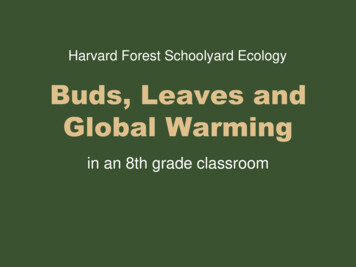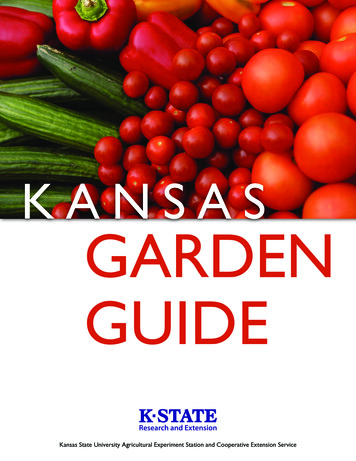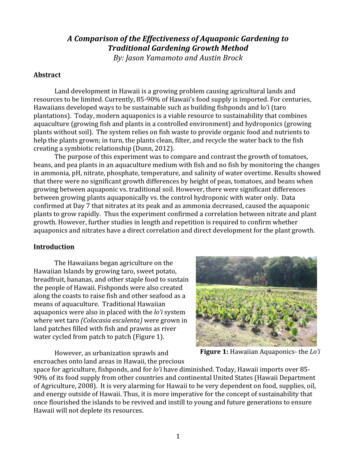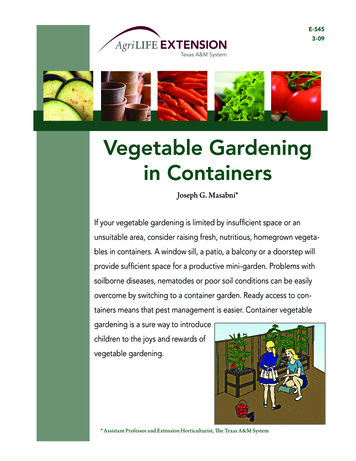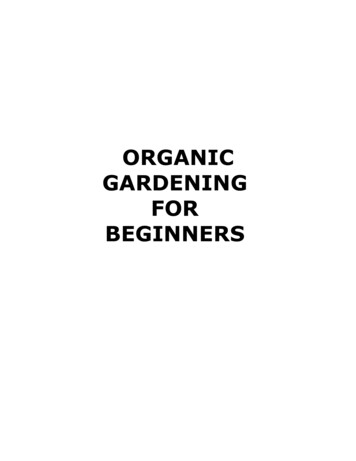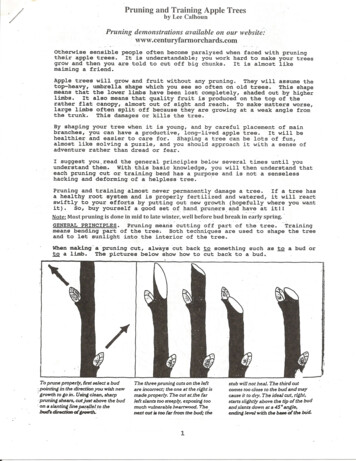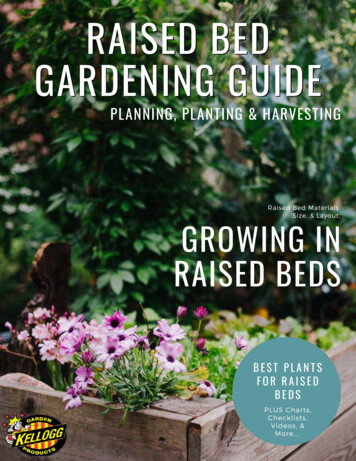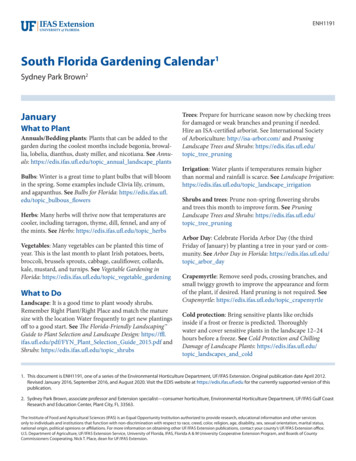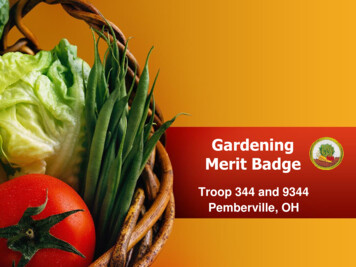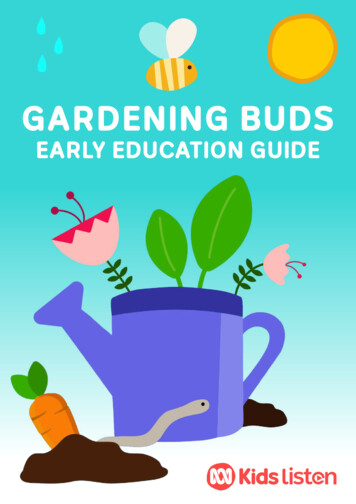
Transcription
GARDENING BUDSEARLY EDUCATION GUIDE
Your Gardening Buds journey starts here!Click on thisto listen online or access via the ABC Kids listen app.Episode 4Episode 1What is a garden?How does your garden fitinto the bigger garden?8-year-old Caylee calls the Gardening Budshotline for some help to get her very owngarden growing. She speaks to GardeningBud Costa, but before they can plan Caylee’sgarden, they go on a walk to find out aboutall the different kinds of gardens. From vergeto vertical, pollinator to pizza, there are somany kinds of gardens!Caylee is getting closer to figuring outwhat kinds of plants she wants to growin her garden, but it’s important toremember that gardens aren’t just for uspeople! Costa talks about how importantgarden spaces are for the birds and bugsthat share our neighbourhoods.Episode 5Episode 2What plans shouldyou chooseWhat have you got?Caylee and Costa use everything they’velearnt so far to choose the plants forCaylee’s garden. But Caylee has a bigquestion for Costa – after she’s plantedher garden, what happens if somethinggoes wrong?Caylee and Costa put their microclimategoggles on to do something very important- a site assessment to understand the spacethat Caylee will grow her garden in. We findout how light, size, temperature and lots ofother things can affect what will work foryou and your garden.Episode 6What happens after youplant your garden?Episode 3How do plants work?Today’s the big day! Caylee and Costaplant Caylee’s seedlings, and set-upher garden. But that’s the easy part –the tricky part is looking after yourplants and keeping them happyand healthy.Caylee makes a special trip to GardeningBuds HQ to learn what plants need to keephealthy and happy - sunlight, water andfood. Then, Costa introduces us to somewiggly little friends and teaches us howwe can help make healthy soil.BACKGROUNDOutdoor education has a long list of positive effects on early development. Infact, numerous studies have found that green-thumbs of all ages garner hugeemotional and physical benefits from gardening. Children need “Vitamin G” (Gfor green), whereby nature is a necessary ingredient for a healthy life.1 This isthe philosophy of ABC Kids listen podcast Gardening Buds, where gardening isregarded as a proven superpower for health and happiness!(Image: Filip Urban, Unsplash.)12
sp Minesp ndi dfuac nge t tim lnesom ca e in sinlmgdsbu ree.sy ndanow .retsgPa thing ver timoing getch hanacwecienitynsibil ditionsopseRonight cleaResrnilieund ing frer o om m ncer ovierw stakes,atering suchasaplant.er.ing ththriveprovid r plants tofoivityCreat scapes,Nutritionding landingdesign lants, or adh potsing pes witarranghcuonal técor.persorden dand gaby growing andhome-gharvestrown fringuit andvegetabto encolesurage healthyeating.fiation oApprec enaturence ofSocial skillsinteracting withpeers angrown-udps during gardeningexperiences.rdependthe integinrloings.expliving thvationObser lsskilncexperieConfidenceand independenceto eensese five s rden.htgusinthe gafeeling a sense of achievement whengardening project goals areaccomplished.yrac dening ingCriticallearnprob thinkinging alem sabolvin ndmaki out yourng dgargted lidecisions a en’s unique ecboutoswhatdiffework ystem anrentspacs besdes.t forSkills andunderstandingsbuilt throughgardeningsaytwalic y ren olsys it iffe toPh tiv n d ingac dy i rden e.bo ga sidetth ng oug usiinov andmoflearni lif Unng edyo ab cyc erur oul stna t t es anhtu e& dira plpl e an ro ngnv tsciro an esnm dsen ins est. ectsinrngadesan ts and be gar d trickeignnraaacgu rent pl to des g tips ces.narneieL diff ag en souureardngngelli ng la ing g ediabmla usiarn ltils, nd le h muooatks hrougttasMEET THE PRESENTERSGardening Buds is hosted by Gardening Australia’s Costa Georgiadis and eight-yearold Caylee Nolan. They take listeners on a journey to make their very own garden.Why make a gardening podcast for children? Well, audio is wonderful way toencourage deep listening and to actively engage childrens’ imaginations, as Costastates “I love the idea of the podcast as a learning space that is green time andnot specifically screen time. Podcasts create a different way of learning,a place to sit and visualise and use the imagination.”34
Teaching and learning emerging from Gardening Buds The Early Years Learning Framework (EYLF)-Practice 5: Learning Environments“Outdoor learning spaces are a feature of Australian learning environments. Playspaces in natural environments include plants, trees, edible gardens, sand, rocks, mud,water and other elements from nature. These spaces invite open-ended interactions,spontaneity, risk-taking, exploration, discovery and connection with nature. They fosteran appreciation of the natural environment, develop environmental awareness andprovide a platform for ongoing environmental education.” -Learning Outcome 2.1Children are connected with and contribute to their world.-Learning Outcome 2.4Children become socially responsible and show respect for the environment.-Learning Outcome 4.2Children develop a range of skills and processes such as problem solving, inquiry,experimentation, hypothesising, researching and investigating.The National Quality Standard (NQS) Quality Area 3:Physical Environment-Element 3.2.1Exploration of the natural environment helps to build children’s competence and playbased learning. It also encourages children to develop an appreciation of the naturalworld, an awareness of the impact of human activity on the environment, and ways inwhich they can contribute to a sustainable future.-Element 3.2.3The service cares for the environment and supports children to become environmentallyresponsible.Planting the seedlingsPhotographer: Jonathan KemperEARLY EDUCATION CURRICULUM LINKSListening to Gardening Buds can support educators to Ignite children’s interest in their natural environment and plan crosscurriculum learning experiences. Plan hands-on outdoor experiences to connect with nature, community andculture. Promote nature pedagogy now embedded in many early childhood educationprograms across Australia. Explore a range of sustainable practices to help develop an ecologicalidentity in young children.5 Early Childhood Australia (ECA) Statement on Young Childrenand Digital Technologies-Relationships:Use digital technologies in early childhood education and care settings to promotesocial interactions between children, peers and adults.-Digital technologies in play and learning:When children experience joint media engagement, including co-listeningto digital content, they can ask questions, put forward ideas & receivefeedback from adults.6
2Plan and design a new gardenInvolve children in planning a new garden. Startby researching different gardens online or inbooks borrowed from your local library; herb,permaculture, vegetable, vertical, native, rooftop,bush tucker and pollinator gardens. Investigatewhich garden suits the size, shape and landscapeof your area. Encourage children’s developingsense of agency (EYLF Learning Outcome 1.2) byinviting them to make decisions that will impactthe success of your garden; positioning plants in relation to the sun, the quality of the soil, theamount of space and how much water is needed.Gardening is STEM learning in action!mathematical understandings as they designa garden and learn new vocabulary relating tosize, length, volume and capacity (EYLF LearningOutcome 5.1).Use the Gardening Buds Diary for children todraw and write about their garden. How do theywant the garden to look? What types of plantsand foods would they like to grow? What insectswould they like to attract? Extend children’sInvestigating vegetable patch.(Image: ABC Kids Early Education).TEACHING AND LEARNING IDEAS1Be a garden detectiveEnjoy a sensory walk in the garden and use your detective skills! Has a flower bloomed where therewasn’t one before? What bug is on that leaf? What is that chirping sound? What is that lovely, or notso lovely, smell? How does that herb taste? What textures can you feel on that tree trunk?Investigate microclimates and find out how they’re influenced by light, shade and weatherconditions. Use children’s drawings to create a visual record of your microclimate. Include gardenwalls, pathways, grass, sunny spots, shady areas, trees, damp or dry parts. Explain how collectingthis information helps gardeners ensure they have created the right garden for the area.Garden drawing by Darcy, 6 years.(Image: ABC Kids listen)78
34Build edible container gardensChildren involved in gardening can begin todevelop an appreciation of where food comesfrom. There is an array of planter boxes and potsto suit spaces of all different shapes and sizes forgrowing vegetables, herbs, native bush tuckerand edible flowers. When choosing a containerfor planting you can even upcycle bottles,seedling trays, old cups and saucers or teapots.build connections with their neighbourhood,community and culture – whilst also developingunderstandings about other environmentallyresponsible practices such as worm farms andcompost bins.Watch Play School Through The Windows film‘Community Garden’.Make an Egghead Planter herb garden usingan egg carton, eggshells, seeds and soil. Milkbottles can be used to make a DIY herb gardenand provide the opportunity for children to becreative by decorating containers with twistedrope and other collage materials (EYLF LearningOutcome 5.3). Certain vegetables are super easyto grow in pots. Try including cherry tomatoes,beans, peas and carrots.Invite families to get involved in creating ediblecontainer gardens, helping to foster a greatersense of community and belonging. Excursionsto local nurseries and community gardensare another valuable way to help childrenSee Costa and Caylee make herbhead planters on ABC Kids YouTube.9Create hanging pots and garden ornamentsGardening is a science and an art. Involvingchildren in arranging a garden and makingornaments to enhance its aesthetic appealoffers valuable opportunities for childrento express their creativity using a range ofmedia (EYLF Learning Outcome 5.3). To makea hanging planter, cut a large plastic bottleabout 1/3 from the bottom and decorate usingcoloured markers. Attach twine to hang theplanter, fill with soil and a small plant e.g. asucculent or perennial. Remember to add asmall hole in the base for water drainage.Sculpt and decorate garden ornaments andstatues using clay and decorate with paint.Painting rocks is another way to brighten up thegarden. Outdoor art experiences also provideopportunities for educators to extend children’sunderstandings about colour, pattern andshape (EYLF Learning Outcome 5.4).withottle planterbakeamtobe.See howC Kids YouTuBAnoeleyaCosta and CSee how to make plant labels anddecorations with Costa and Cayleeon ABC Kids YouTube.10
Additional Resources1.ABC Kids listen: Gardening - A Superpower for your kids!2.Play School Green Team: Early Education Notes3. ABC Gardening Australia4. ABC Everyday: A Beginner’s Guide to Growing Flowers in PotsSee how to make a magical minigarden with Costa and Cayleeon ABC Kids YouTube.55.Modern Teaching Blog: Sustainability in the Early Years6.Little Green Steps Western Australia (LGSWA)7.Climbing the Little Green Steps: How to promote sustainability within early childhoodservices in your local area8.Environmental Education in Early Childhood9.Queensland Early Childhood Sustainability Network (QECSN)10. NSW Early Childhood Environmental Education Network (NSW ECEEN)11. Early Education for Sustainability South Australia Inc. (EESSA)12. Because We Care - Education for Sustainability in ActionDesign a magical, miniature landscape gardenTerracotta pots or old cooking pots and pansprovide the perfect space to create a MiniatureLandscape Garden. Use a range of naturalmaterials and loose parts (e.g. pebble mulch,rocks, pop sticks, small ceramic bowls, shells,fallen bark, pine cones, wooden peg people,seedling trays) to design and make thesemagical gardens.Choose a few small plants that require thesame conditions e.g. succulents and cacti.Invite children to use containers stacked ontop of each other to create different levelsand layers. Promote children’s imaginationand creativity (EYLF Learning Outcome 4.1)by encouraging them to create a garden fortheir favourite television or book character.Make pathways that twist and turn, and createsurprises for the characters. This fantasticgardening experience will inspire children’ssmall world imaginative play and encouragestorytelling (EYLF Learning Outcome 5.3).1113. Koori Curriculum: Top Tips for Creating a Bush Tucker Garden14. Sustainability in Action in Early Childhood Settings15. Costa And Caylee Make Plant Labels Gardening Buds ABC Kids Youtube16. Costa and Caylee make herb head Gardening Buds ABC Kids YouTube17. Costa And Caylee Make Bottle Planters Gardening Buds ABC Kids YouTube18. How To Make A Magical Mini Garden - With Costa And Caylee Gardening Buds ABC Kids YouTubeReferences1.The Natural Learning Initiative. (2012). Benefits of Connecting Childrenwith Nature.2.Ann Pelo. (2013). The Goodness of Rain: Developing an Ecological Identityin Young Children. Exchange Press.12 ABC Kids Early Education 2021
5 Design a magical, miniature landscape garden Terracotta pots or old cooking pots and pans provide the perfect space to create a Miniature Landscape Garden.Use a range of natural materials and .

